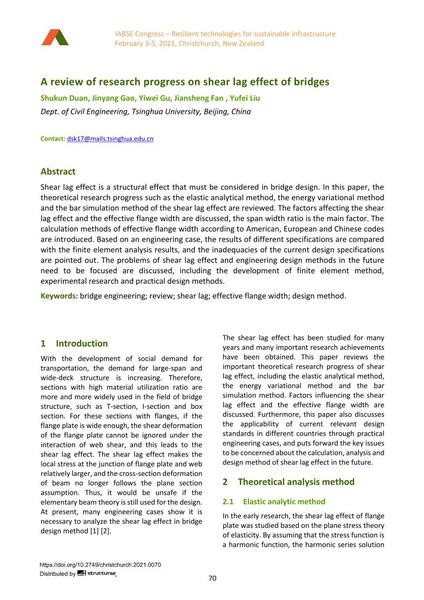A review of research progress on shear lag effect of bridges

|
|
|||||||||||
Détails bibliographiques
| Auteur(s): |
Shukun Duan
(Dept. of Civil Engineering, Tsinghua University, Beijing, China)
JinYang Gao (Dept. of Civil Engineering, Tsinghua University, Beijing, China) Yiwei Gu (Dept. of Civil Engineering, Tsinghua University, Beijing, China) Jiansheng Fan (Dept. of Civil Engineering, Tsinghua University, Beijing, China) Yufei Liu (Dept. of Civil Engineering, Tsinghua University, Beijing, China) |
||||
|---|---|---|---|---|---|
| Médium: | papier de conférence | ||||
| Langue(s): | anglais | ||||
| Conférence: | IABSE Congress: Resilient technologies for sustainable infrastructure, Christchurch, New Zealand, 3-5 February 2021 | ||||
| Publié dans: | IABSE Congress Christchurch 2020 | ||||
|
|||||
| Page(s): | 70-78 | ||||
| Nombre total de pages (du PDF): | 9 | ||||
| DOI: | 10.2749/christchurch.2021.0070 | ||||
| Abstrait: |
Shear lag effect is a structural effect that must be considered in bridge design. In this paper, the theoretical research progress such as the elastic analytical method, the energy variational method and the bar simulation method of the shear lag effect are reviewed. The factors affecting the shear lag effect and the effective flange width are discussed, the span width ratio is the main factor. The calculation methods of effective flange width according to American, European and Chinese codes are introduced. Based on an engineering case, the results of different specifications are compared with the finite element analysis results, and the inadequacies of the current design specifications are pointed out. The problems of shear lag effect and engineering design methods in the future need to be focused are discussed, including the development of finite element method, experimental research and practical design methods. |
||||
